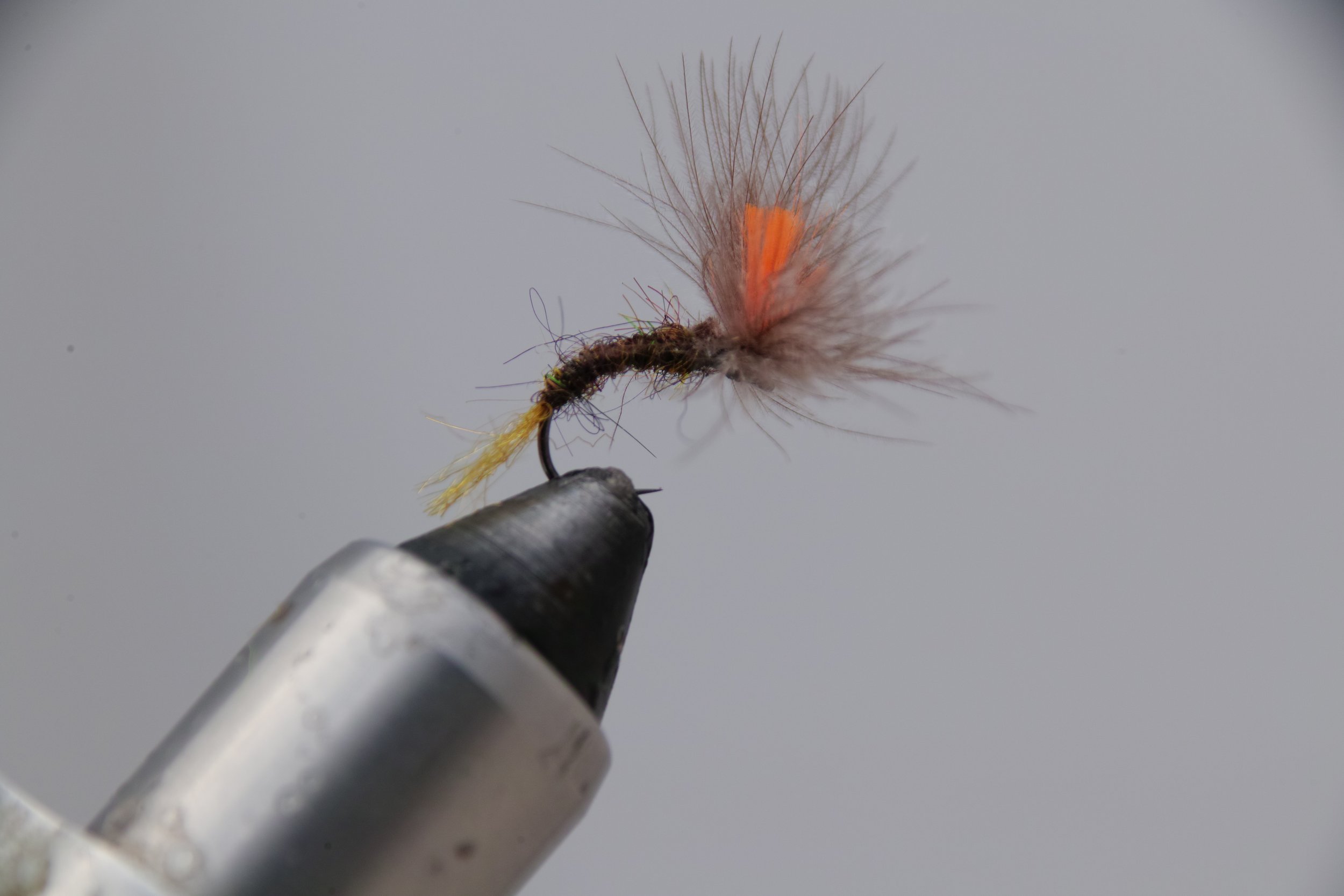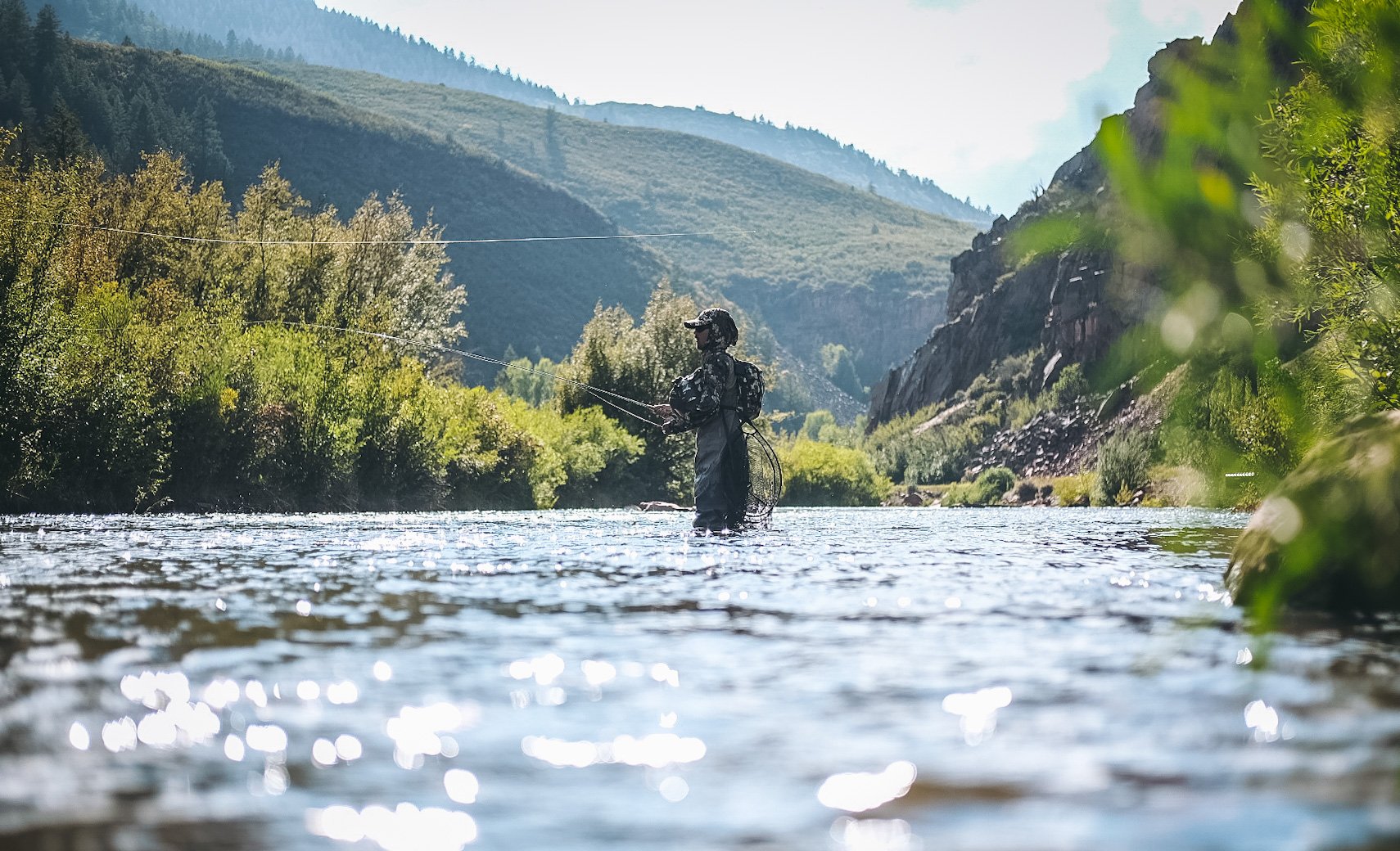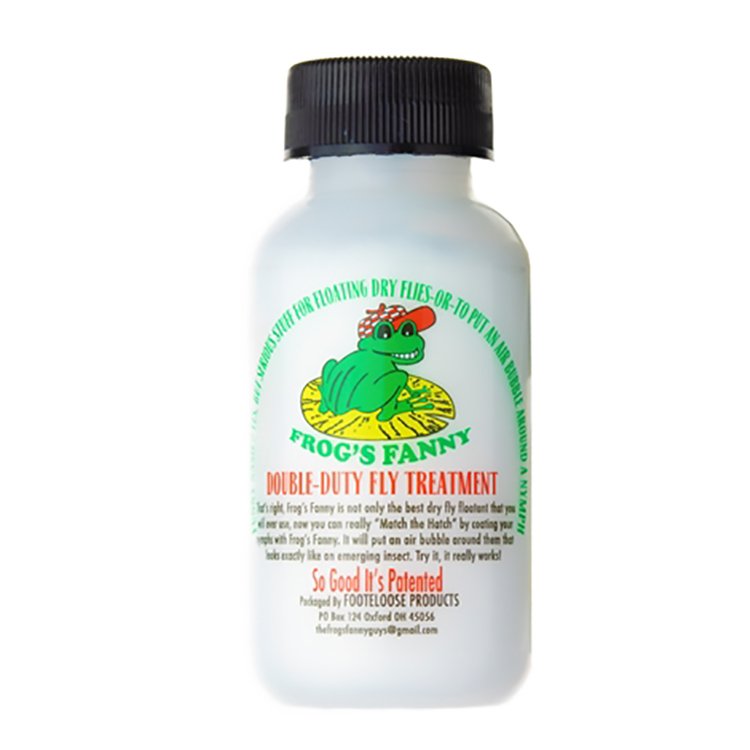Advanced Dry Fly Fishing
Dry fly fishing can leave lasting memories in every angler's mind, from hardcore dry fly purists to beginners watching their first fish come crush a hopper on a summer day. Dry fly fishing is something we all think about and is arguably one of the most exciting ways to catch trout year-round. It can also present moments of extreme frustration and bewilderment as a fish swims over, only to disappear back to the depths leaving you to wonder what could have gone wrong. Was it my tippet choice? Maybe the fly? Or drag in my drift? In this blog, I want to shed some light on dry fly tactics that have led me to have more success with dry fly fishing in competitions and my personal fishing.
Fishing a stretch of the Frying Pan during an incredible drake hatch PC: Russ Miller
Leaders, Drag, and Micro-drag
One of the first and most important topics I want to touch on is leader length and design. It is so important for fishing dry flies and yet overlooked by many anglers throughout the year. While fishing in competitions I use a 20ft dry fly leader, some people might think this is way too long but its advantages are unparalleled compared to a store-bought 9ft or 12ft leader.
First, with a long and correctly tapered dry fly leader, you can eliminate drag without aerial mends or mending post cast, which is one of the main components of being successful with a dry fly. By building out a leader that puts slack into your presentation we can worry less about mending and more about accuracy and approach. The style of dry fly fishing that I have adopted has come from watching and fishing with ultra-successful Spanish and French competitors. In Europe, especially in the competitive scene, many of the teams are known for fishing dry flies with deadly success rates, and many of those techniques can be adopted into the fishing we do here in the United States.
A lot of competition dry fly leaders are meant to “stack” the tippet almost on top of itself at the end of the cast giving the dry fly ample room to drift drag-free and have an unhindered drift. This gives the angler a huge advantage, especially when fishing dry flies that are size 16 and below. Small flies are easily maneuvered by unwanted tension in the leader from micro currents. Without a doubt, this was one of the most surprising aspects of leader design that I was shown over the years, and to this day I am still amazed at how effective it can be.
Building a proper dry fly leader takes a lot of trial and error. Finding a formula I don’t have to alter too much for most applications while fishing in new rivers has taken me even longer. Granted no leader is going to do it all but the least amount of manipulation I have to do on stream, the better. I focus on building leaders that have a high turnover from fly line to fly. A common mistake in leader design is that the leader lacks energy transfer required to turn over a fly at lengths of 18-20ft. One way to test this is to cast the leader with a fly attached and see if the tippet hits the water before the fly. If the fly is touching down before the leader hits the water the turnover rate is too high ( high amount of hinge) and this can be fixed simply by adding a few feet of tippet in most circumstances. If the tippet is stretched out all the way when the fly hits the water it will immediately start micro-dragging when it hits the water, leaving the angler to throw an immediate mend, moving the fly off course. In most cases with these longer leaders, especially at shorter distances, I find myself rarely having to mend during the drift or not mending at all. A correct leader build lays out 70% of the leader straight, then the energy transfer punches the tippet section out and the fly parachutes down softly as tippet stacks up in a slack pile. This is the design and function of the George Harvey slack leader. ( link below)
Let's talk micro-drag. In situations where fish are pressured or are just downright picky, I believe this to be a huge factor in if the fish eats the fly or not. Just like nymphing if you have a cross current drift that is working against the natural flow, more times than not a fish won't eat it. With dry fly fishing the same is true, we just have a visual example to study and correct. One of the first ways to get rid of micro-drag is just to downsize the tippet choice. Lighter line creates less surface tension on the water, just like in nymphing, and it will greatly help reduce drag and lead to a clean drift. I use 7x and 6.5x about 70% of the time while dry fly fishing when the situation allows it. Obviously some scenarios may require 5x, 4x, or 3x depending on your fish size and fly size. Using a smaller tippet also helps with the “stack” or “coil” we want to achieve in the slack leader and evenly distributes the leader and tippet in a more subtle nature.
The next weapon in the arsenal for combating micro-drag is silicone mucilin. I use this product to grease my nymphing leader as well. Any Loon or gel-like dry fly floatant will work but the green Mucilin silicone seems to stay on the leader longer without re-application. You can find this in most fly shops for a couple of dollars. I fish fluorocarbon tippet with dry flies which helps keep the tippet up on the surface and not dragged down where it is more susceptible to current. Leaving the last few inches or so ungreased at the fly will help keep the tippet invisible, leaving it to sit just under the water.
My beat during the 2016 Youth World Championships in Spain where stealth, technical casts and clean drifts were needed to catch fish.
Fly selection, Materials, and Floatant 101
Fly selection can be crucial for dry fly fishing. Color, size and wing material all play an important role when choosing a fly. For me, CDC feathers are used in tying about 60% of the more imitative flies in my box. Their ability to shed water and not add weight to the fly makes it a clear winner. The abundance of colors make them very adaptable for different types of hatches and can be tied with multiple wing styles for various presentations. CDC is also a very light feather and I find represents the weight of a true fly. This gives it very natural motion and presentation in the water and makes it easy for a long dry fly leader to turn over. Air resistance of the fly is a key aspect in the slack leader presentation. If you try to throw a chubby chernobyl on a 20 foot slack leader with 7 feet of 6x, it will just spin, won’t turn over, and make a mess. This leader style is highly effective for fishing most hatches outside of stonefly and grass hoppers which require a more aggressive leader build.
Most of my inspiration for fly styles comes from Spanish and Czech fishermen who adapt a lot of split-wing designs with very visible posts that you can see from a distance. Some of the wing types I tie are split wing, fold over wing, and shuttle cock wing. All of these wing types have the fly ride differently in the water, for instance, split-wing is great for choppy or broken water because it stands up tall, while a shuttle cock wing is better for slower flows and presents an emerger or cripple style fly.
Here are some different wing styles on some confidence dries:





There are many floatants on the market today but I keep just a few in my pack. Depending on the material in the fly you are fishing, one floatant may work better than others. The first one is Frogs Fanny which is a standard fumed hydrophobic silica power. This brand was introduced to me on the Youth USA Fly Fishing Team and I have been fishing it since then for about 7 years. It is perfect for CDC wings, synthetics, and everything in between. Powder will extract moisture from a fly, while liquid seals moisture out. I highly recommended taking the applicator brush and smashing it down on a flat surface giving the brush more surface area allowing the fly to be dried off quickly. The next products are the Shimazaki Dry Spray and Liquid. I carry a bottle of both and they are worth spending the money on every time. One quick spray or dip into these products will keep any synthetic material riding high for hours and it works just as well on natural materials as well. Having an amadou patch available on my chest pack is perfect for getting CDC flies dried off before adding these applications. Taking all the moisture out of the fly in just a few seconds helps get flies prepped faster to fish longer. One of the last products I use before hitting the river is Preen Oil or (natural fly dressing) from Trout Hunter. I will apply this at the vise on CDC flies as it helps to seal water out of the fly and keeps the feathers from getting swamped every time a fish is landed.
Rods, Lines, and Leader Formulas
Everyone has a preferred rod for nymphs, dry flies, streamers but a select few rods seem to elevate the game of the angler in my opinion. For my standard dry fly fishing, I use a 3 weight rod. People might think that this is very light but when fishing tippets of smaller diameter I want to match it with a rod that can provide lots of cushion. The rod of choice I use is a 10ft 3wt. It is a very versatile rod that I also use in nymphing applications. This is the best “do it all” configuration I have found out there. I have been fishing two versions of the Greys Streamflex for about 6 years and it was the first euro style rod that I owned. They are extremely dependable with a mid-flex action and are some of the most durable rods on the market today. I will also note they are also are virtually indestructible. Longer rods are nice when we switch to nymphing but they lack the accuracy of a shorter rod for dry fly applications. If you are having trouble turning over leaders it can be worth while to find a 8ft or 9ft rod for dry fly fishing because they are easier to cast than longer rods.
Fly lines play a huge factor in how a dry fly setup is put together and there are many available options for lines on the market today. For me, I carry two reels. One with a Cortland Finesse Line, and one with a Scientific Anglers VPT line. I tend to use the Cortland Finesse line for rivers with slower flows or tight and technical creeks with low wind. This line excels in accuracy and subtle presentation along with a soft blue color it is perfect for stalking picky fish. Along with this, the Finesse Line is great for reaching out at far distances and the low profile of the line makes a very minimal splash and is easily manuevered on a pickup cast. One thing that tends to baffle me is the amount of highlighter yellow and orange colored dry fly lines on the market today. if you are looking for a new line stick to something olive, light blue, or any color that isn’t as obtrusive. The Scientific Anglers VPT line has a slightly heavier front taper allowing it to punch through wind or make fast false casts with ease. Most times I will load a 4wt line on the 3wt rod. Overloading a rod allows for effortless casting and great turnover with small flies. Picking a dry fly line for the right rod can be hard but I would urge people to experiment with all types of lines and find one that works best for them and use that as a benchmark.
At this point in the blog I wanted to share a couple of different leader variations that have worked very well for me in the past and I still fish today. The only thing I want to express about some of these leaders is incorporating a somewhat faster casting style into these leaders. When I first tied these up I was discouraged about how they laid out while using a very traditional dry fly cast. After watching mentors, I quickly learned that I needed to speed things up in my casting stroke and pace.
Finesse Dry Fly Leader:
Trout Hunter Rene Harrop Finesse Leader 12ft (6x)
2.5ft of trout hunter fluoro (6x)
2ft of trout hunter fluoro (6.5x)
3.5ft of trout hunter fluoro (7x)
Distance Dry Fly Leader:
8ft of 12lb Maxima Chameleon
6ft of 8lb Maxima Chameleon
1.5 ft of trout hunter fluoro (3x)
1.5 ft of trout hunter fluoro(4x)
2.5 ft of trout hunter fluoro (5x)
3ft of trout hunter fluoro(6x)
Large Dry Fly Leader:
Trout Hunter Nylon Leader 10ft (3x)
3ft of trout hunter fluoro (4x)
2.5ft of trout hunter fluoro (5x)
Products available on our website:
available in 3WT and 4WT
available in 3x-7x
Links:
-Rene Harrop Leader
-https://trouthunter.shoplightspeed.com/trouthunter-rene-harrop-signature-leaders-14.html
-Silicone Mucilin (green can)
-https://www.amazon.com/ACCESSORIES-Mucilin-Silicone-Dressing-Green/dp/B005PW7B8M









